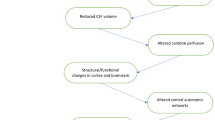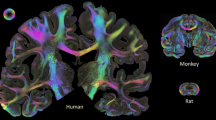Summary
Preischemic hyperglycemia aggravates brain damage following transient ischemia, and adds some special features to the damage incurred, notably a high frequency of postischemic seizures, cellular edema, and affectation of additional brain structures, such as the substanta nigra pars reticulata (SNPR). We raised the question whether mild intra-ischemic hypothermia (32–33° C), known to reduce selective neuronal vulnerability in normoglycemic subjects, also ameliorates the characteristic damage observed in hyperglycemic animals. To that end, two series of experiments were performed. In the first, normo- and hypothermic animals were subjected to 10 min of ischemia during hyperglycemic conditions (plasma glucose 20–25 mmol · 1-1), and allowed either 15 h or 1 week of recovery. In the second, both normo- and hyperglycemic animals were subjected to 15 min of ischemia (at normal or reduced temperature) and surviving animals were studied after 1 week of recovery. All normothermic, hyperglycemic animals developed postischemic seizures and died within the first 24 h. Mild hypothermia afforded substantial protection. Thus, 6/7 hypothermic animals subjected to 10 min of ischemia survived 1 week of recovery and none developed postischemic seizures. Of the hypothermic animals subjected to 15 min of ischemia 6/11 survived for 1 week, only one of which developed seizures. Protection by hypothermia was also shown by the histopathological analysis. Experiments with 10 min of ischemia and 15 h of recovery showed the expected damage in normothermic, hyperglycemic subjects. Hypothermia markedly reduced damage in all vulnerable structures, including the cingulate cortex and SNPR. The protection was most pronounced in the caudoputamen, where no affected neurons were seen in the hypothermic subjects. The experiments with 15 min of ischemia confirmed previous findings that mild hypothermia protects normoglycemic animals against the insult. The results also showed that hypothermia prevented most of the exaggeration of damage caused by hyperglycemia. However, under hypothermic conditions hyperglycemia still augmented damage in the cingulate cortex, medial and lateral venteroposterior thalamic nuclei, and SNPR, structures specifically damaged under hyperglycemic, normothermic conditions. This suggests that hypothermia has less of a protective effect on mechanisms causing such damage than on neuronal damage in the classic selectively vulnerable regions, particularly the caudoputamen.
Similar content being viewed by others
References
Auer R, Ingvar M, Nevander G, Olsson Y, Siesjö BK (1986) Early axonal lesion and preserved microvasculature in epilepsy induced hypermetabolic necrosis of the substantia nigra. Acta Neuropathol (Berl) 71:207–215
Auer RN, Olsson Y, Siesjö BK (1984) Hypoglycemic brain injury in the rat. Correlation of density of brain damage with the EEG isoelectric time: a quantitative study. Diabetes 33:1090–1098
Busto R, Dietrich WD, Globus MY-T, Valdés I, Scheinberg P, Ginsburg MD (1987) Small differences in intraischemic brain temperature critically determine the extent of ischemic neuronal injury. J Cereb Blood Flow Metab 7:729–738
Busto R, Globus MY-T, Dietrich WD, Martinez E, Valdés I, Ginsburg MD (1989) Effect of mild hypothermia on ischemia induced release of neurotransmittors and free fatty acids in rat brain. Stroke 20:904–910
Chopp M, Knight R, Tidwell CD, Helpern JA, Brown E, Welch KMA (1989) The metabolic effects of mild hypothermia on global cerebral ischemia and recirculation in the cat: comparison to normothermia and hyperthermia. J Cereb Blood Flow Metab 9:141–148
Folbergrová J, MacMillan V, Siesjö BK (1972) The effect of moderate and marked hypercapnia upon the energy state und upon the cytoplasmic NADH/NAD + ratio of the rat brain. J Neurochem 19:2497–2505
Folbergrová J, Smith ML, Siesjö BK (1989) Decrease in glutamate decarboxylate activity in substantia nigra and caudoputamen following transient hyperglycemic ischemia in the rat. J Cereb Blood Flow Metab 9:897–901
Francis A, Pulsinelli W (1982) The response of GABAergic and cholinergic neurons to transient cerebral ischemia. Brain Res 243:271–278
Gale K (1985) Mechanisms of seizure control mediated by gammaaminobutyric acid: role of the substantia nigra. Fed Proc 14:2114–2124
Globus MY-T, Busto R, Dietrich WD, Martinez E, Valdés I, Ginsburg MD (1988) Intra-ischemic extracellular release of dopamine and glutamate is associated with striatal vulnerability to ischemia. Neurosci Lett 91:36–40
Hirsch H, Müller HA (1962) Funktionelle und histologische Veränderungen des Kaninchengehirns nach kompletter Gehirnischämie. Pflügers Archiv 275:277–291
Houser CR, Vaughn JE, Barber RP, Roberts E (1980) GABA neurons are the major cell type of the nucleus reticularis thalami. Brain Res 200:341–354
Hägerdahl M, Harp J, Siesjö BK (1975) Effect of hypothermia upon organic phosphates, glycolytic metabolites, citric acid cycle intermediates and associated amino acids in rat cerebral cortex. J Neurochem 24:743–748
Inamura K, Smith ML, Olsson Y, Siesjö BK (1988) Pathogenesis of substantia nigra lesions following hyperglycemic ischemia: changes in energy metabolites, cerebral blood flow, and morphology of pars reticulata in a rat model of ischemia. J Cereb Blood Flow Metab 8:375–384
Jones EG (1983) The thalamus. In: Emson PC (ed) Chemical neuroanatomy. Raven Press, New York, pp 257–276
Kalimo H, Rehncrona S, Söderfeldt B, Olsson Y, Siesjö BK (1981) Brain lactic acidosis and ischemic cell damage. 2. Histopathology. J Cereb Blood Flow Metab 1:313–327
Lundgren J, Mans A, Siesjö BK (1990a) Ischemia in normo- and hyperglycemic rats: plasma energy substrates and hormones. Am J Physiol 258 (Endocrinol Metab 21):E767-E774
Lundgren J, Cardell M, Wieloch T, Siesjö BK (1990b) Presichemic hyperglycemia and postischemic alterations in brain pyruvate dehydrogenase activity. J Cereb Blood Flow Metab 10:536–541
Michenfelder JD, Theye RA (1970) The effects of anesthesia and hypothermia on canine cerebral ATP and lactate during anoxia produced by decapitation. Anesthesiology 33:430–439
Minamisawa H, Nordström CH, Smith ML, Siesjö BK (1990a) The influence of mild body and brain hypothermia on ischemic brain damage. J Cereb Blood Flow Metab 10:365–374
Minamisawa H, Smith ML, Siesjö BK (1990b) The effect of mild hyperthermia and hypothermia on brain damage following 5, 10, and 15 min of forebrain ischemia. Ann Neurol 28:26–33
Moshe SL, Albala BJ (1984) Nigral muscimol infusions facilitate the development of seizures of immature rats. Dev Brain Res 13:305–308
Myers RE (1979) Lactic acid accumulation as a cause of brain oedema and cerebral necrosis resulting from oxygen deprivation. In: Korobkin R, Guilleminault G (eds) Advances in perinatal neurology. Spectrum, New York, pp 85–114
Myers RE, Yamaguchi S (1977) Nervous system effects of cardiac arrest in monkeys. Arch Neurol 34:65–74
Nevander G, Ingvar M, Auer R, Siesjö BK (1985) Status epilepticus in well oxygenated rats causes neuronal necrosis. Ann Neurol 18:281–290
Petito CK, Pulsinelli WA, Jacobson G, Plum F (1982) Edema and vascular permeability in cerebral ischemia: comparison between ischemic neuronal damage and infarction. J Neuropathol Exp Neurol 41:423–436
Pontén U, Ratcheson RA, Salford LG, Siesjö BK (1973) Optimal freezing conditions for cerebral metabolites in rats. J Neurochem 21:1127–1138
Pulsinelli WA, Brierly JB, Plum F (1982a) Temporal profile of neuronal damage in a model of transient forebrain ischemia. Ann Neurol 11:491–498
Pulsinelli WA, Waldman S, Rawlinson D, Plum F (1982b) Moderate hyperglycemia augments ischemic brain damage: a neuropathologic study in the rat. Neurology 32:1239–1246
Rehncrona S, Rosén I, Siesjö BK (1980) Excessive cellular acidosis: an important mechanism of neuronal damage in the brain? Acta Physiol Scand 110:435–437
Rehncrona S, Rosen I, Siesjö BK (1981) Brain lactic acidosis and ischemic cell damage: biochemistry and neurophysiology. J Cereb Blood Flow Metabol 1:297–311
Roberts E (1986) Failure of GABAergic inhibition: a key to local and global seizures. In: Delgado-Escueta AV, Ward AAJ, Woodbury DM, Porter RJ (eds) Advances in neurology. Raven Press, New York, pp 319–341
Siemkowicz E (1985) The effect of glucose upon restitution after cerebral ischemia: a summary. Acta Neurol Scand 71:417–427
Siemkowicz E, Hansen AL (1978) Clinical restitution following cerebral ischemia in hypo-, normo- and hyperglycemic rats. Acta Neurol Scand 58:1–8
Siesjö BK (1988a) Acidosis and ischemic brain damage. Neurochem Pathol 9:31–88
Siesjö BK (1988b) Mechanisms of ischemic brain damage. Crit Care Med 16:954–963
Smith ML, Auer RN, Siesjö BK (1984) The density and distribution of ischemic brain injury in the rat following 2–10 min of forebrain ischemia. Acta Neuropathol 64:319–332
Smith ML, Kalimo H, Warner DS, Siesjö BK (1988) Morphological lesions in the brain preceding the development of postischemic seizures. Acta Neuropathol 76:253–264
Smith ML, von Hanwehr R, Siesjö BK (1986) Changes in extra- and intracellular pH in the brain during and following ischemia in hyperglycemic and in moderately hypoglycemic rats. J Cereb Blood Flow Metab 6:574–583
Thorn W, Scholl H, Pfleiderer G, Meuldener B (1958) Stoffwechselvorgänge im Gehirn bei normaler und herabgesetzter Körpertemperatur unter ischämischer und anoxischer Belastung. J Neurochem 2:150–165
Vacanti FX, Ames A (1984) Mild hypothermia and Mg++ protect against irreversible damage during CNS ischemia. Stroke 15:695–698
Warner DS, Smith ML, Siesjö BK (1987) Ischemia in normo- and hyperglycemic rats: effects on brain water and electrolytes. Stroke 18:464–471
Welsh F, Ginsburg M, Rieden W, Budd W (1980) Deleterious effect of glucose pretreatment on recovery from diffuse cerebral ischemia in the cat. Stroke 11:355–363
Wieloch T (1985) Neurochemical correlates to regional selective neuronal vulnerability. Progr Brain Res 63:69–85
Author information
Authors and Affiliations
Rights and permissions
About this article
Cite this article
Lundgren, J., Smith, ML. & Siesjö, B.K. Influence of moderate hypothermia on ischemic brain damage incurred under hyperglycemic conditions. Exp Brain Res 84, 91–101 (1991). https://doi.org/10.1007/BF00231764
Received:
Accepted:
Issue Date:
DOI: https://doi.org/10.1007/BF00231764




